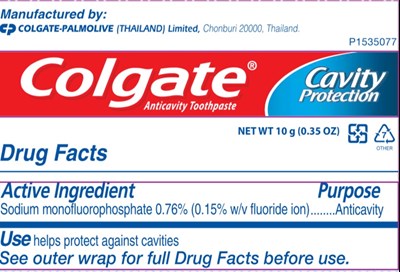Product Images Colgate Anticavity Kit
View Photos of Packaging, Labels & Appearance
Product Label Images
The following 5 images provide visual information about the product associated with Colgate Anticavity Kit NDC 56153-001 by Ming Fai Industrial (shenzhen) Co. Ltd, such as packaging, labeling, and the appearance of the drug itself. This resource could be helpful for medical professionals, pharmacists, and patients seeking to verify medication information and ensure they have the correct product.
10 - 10g

This is a description of Colgate Anti-Cavity Toothpaste manufactured by Colgate-Palmolive in Thailand. The toothpaste contains sodium monofluorophosphate, which serves as an active ingredient and helps protect against cavities. The outer wrap of the toothpaste provides the full drug facts, which a user should read carefully before using. The size of the product is 10 (0.35 oz).*
drug facts - Colgate Drug Facts1

This is a drug facts label for a toothpaste, which contains Sodium monofluorophosphate 0.76% for cavity prevention. The toothpaste is intended for use by adults and children over two years old, and should be used twice a day or after each meal, with a pea-sized amount for children aged between 2 and 6 with adult supervision. It contains several inactive ingredients, including sorbitol and cellulose gum. The toothpaste should be kept away from children under 6, and in case of accidental swallowing, medical help or Poison Control should be contacted immediately.*
label - Label2

This is a description for Colgate Cavit Anticavity Toothpaste manufactured by Colgate-Palmolive in Thailand. The toothpaste helps protect against cavities and contains sodium monofluorophosphate 0.76%. The net weight is 5g (0.1702 oz.). The full drug facts are available on the outer wrap.*
* The product label images have been analyzed using a combination of traditional computing and machine learning techniques. It should be noted that the descriptions provided may not be entirely accurate as they are experimental in nature. Use the information in this page at your own discretion and risk.

